Homemade Breakfast Sausage Recipe (Links or Patties)
This post may contain affiliate links. See my disclosure policy.
Nothing beats homemade and homemade breakfast sausages are no exception! Tender, moist, and wonderfully flavorful, this homemade breakfast sausage recipe is entirely from scratch without any fillers or junk ingredients and I think you’ll agree that they’re the best sausages you’ve tasted!
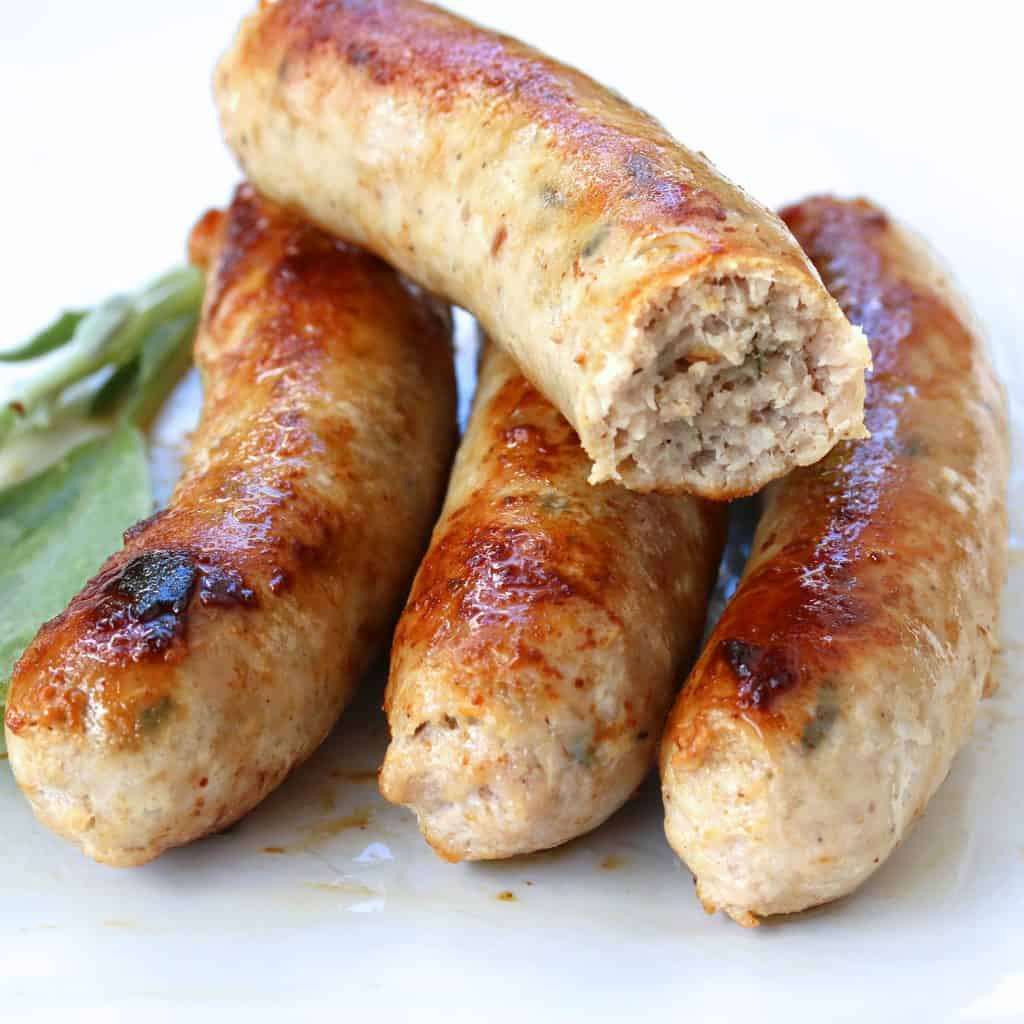
Why I Love This Breakfast Sausage
Truly nothing beats the quality and flavor of homemade breakfast sausage! Not only do they taste better, you know exactly what’s in them and what isn’t. You have full control over the quality of the ingredients that go into making them and good choices always pay off in the end.
Charctuterie-making has been a hobby of mine for several years now. I started off with the simple art of making fresh sausages like these homemade breakfast sausage links and then started making my own bacon and Canadian bacon. Eventually I graduated into making the more complicated forms of charcuterie, namely fermented and dry-cured meats including salami, pepperoni, coppa and pancetta.
While dry-cured meats require the utmost precision, care and monitoring (not to mention additional specialized equipment), fresh sausages on the other hand are not only super easy to make, they’re also a lot of fun! When I make sausages I usually like to make the effort of pulling out the meat grinder and sausage stuffer worth it, so I make a bulk batch that I can freeze – then I can conveniently pull them out and throw them in the frying pan as needed.
These breakfast sausages are a favorite staple in our home. We regularly pick up ground pork from a local farmer down the road and make a large batch of these to freeze to have on hand. Whether you’re already an experienced sausage-maker or are just getting started, you’re going to LOVE this easy homemade breakfast sausage recipe!

Sausage Making Resources
Before we get started on this breakfast sausage recipe I want to share a few helpful resources with you. Once you get the basics down on how to make sausages, you can create your own flavors and combinations which is what I particularly enjoy doing. But having one or two good books to learn and practice from is a a must. I have combed through many books on charcuterie and sausage-making over the past few years and these ones continue to be my favorites:
Great Sausage Recipes and Meat Curing by Kutas is a classic and one of the first comprehensive books written on the subject. It’s a no-nonsense, straight-forward book packed full of recipes. Charcuterie: The Craft of Salting, Smoking and Curing by Ruhlman has likewise been a very popular book. The current edition is revised and updated. I have the previous edition and there are inaccuracies and errors in it that the newest edition has reportedly fixed, but I still hear complaints about it. Nevertheless, I like this book as a source of inspiration for some great recipes. Olympia Provisions: Cured Meats and Tales from an American Charcuterie is the newest kid on the block and it is both a fun and inspiring read. The author, Elias Cairo, is the founder of Olympia Provisions in Portland Oregon and owns several restaurants and butcher shops there. This book features several of his most popular recipes. The recipes are very well crafted and you’ll love the end results.
The final two books are both written by Stanley & Adam Marianski: The Art of Making Fermented Sausages and Home Production of Quality Meats and Sausages. While these are a very dry read, definitely not packed with inspirational stories or beautiful photographs, I consider these indispensable to anyone who is serious about wanting to learn the art of charcuterie and sausage-making. Consider them the most comprehensive how-to manuals on the market. There is not a single question that isn’t answered in these books. Especially if you are planning on dabbling in dry-cured meats, The Art of Making Fermented Sausages is a MUST.
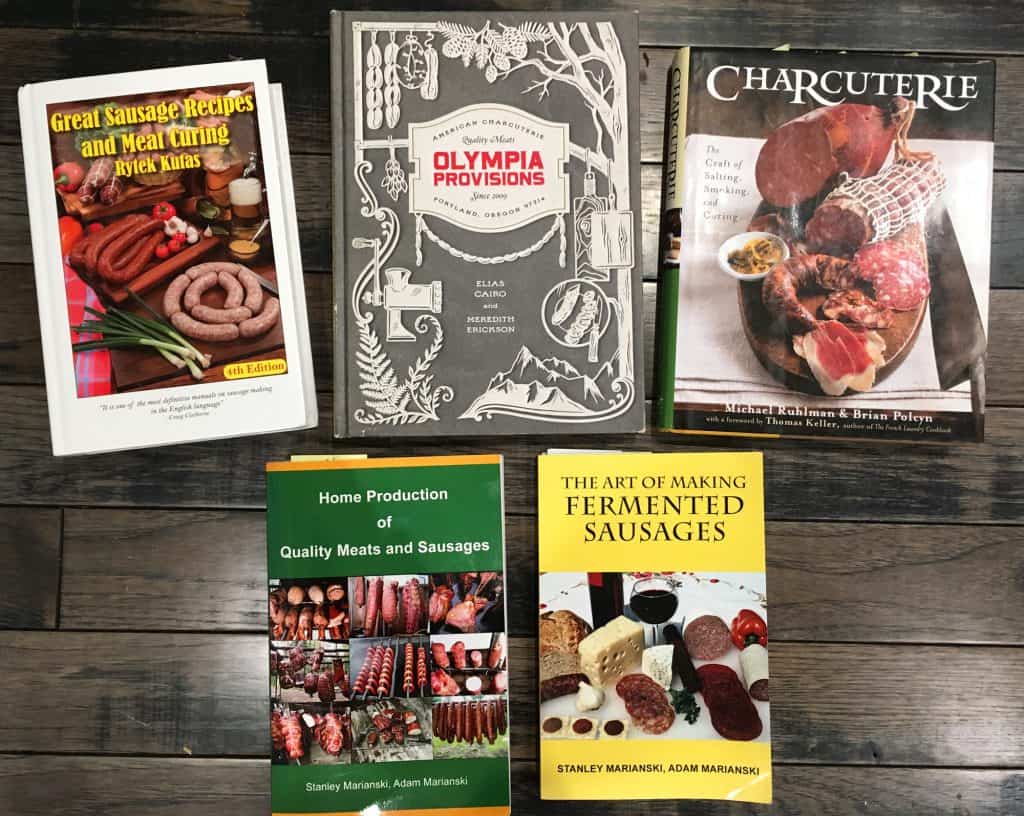
Breakfast Sausage Recipe
Let’s get started!
Note About Making Breakfast Sausage Patties: The pictures below show the process of stuffing the breakfast sausage meat into casings to make breakfast sausage links. If you prefer, you can skip the stuffing process and make patties instead. I do it all the time! Instructions are provided below.

Cut the pork butt into 1/2 inch chunks and freeze them for about 45 minutes to get them to a temperature of 32 degrees F (0 celsius). (See note in recipe box below for explanation as to why keeping the meat is so critical.)
Grind the pork through a 1/4 inch (6mm) die. Grind the meat quickly into the bowl of a stand mixer (ideally have the bowl set atop an ice bath to keep the meat cold) and then grind it all a second time. Chill the meat in the refrigerator while you assemble the spice mixture.
I use the STX International Turbo Force Electric Meat Grinder. With 3000 watts, 3 speeds and a 3-year warranty, it has high reviews and comes top recommended by most review sites as the best bang for the buck.
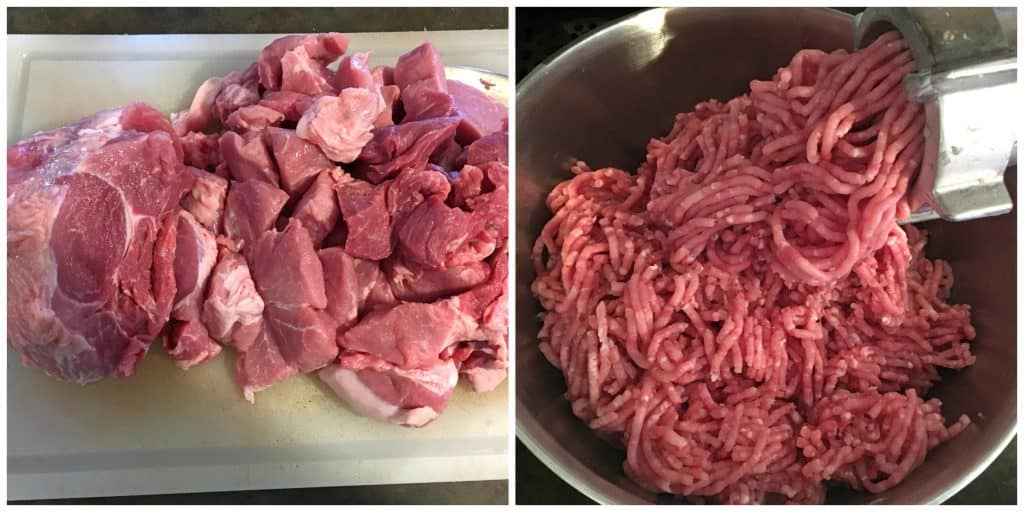
In a bowl combine the salt, sage, thyme, ginger, white and black pepper, garlic and nutmeg.
Remove the ground meat from the fridge and place it on the stand mixer fitted with a paddle attachment. Add the spice mixture and the ice water.
Note: For variation you can add 1 cup of maple syrup for sweeter Homemade Maple Breakfast Sausages.
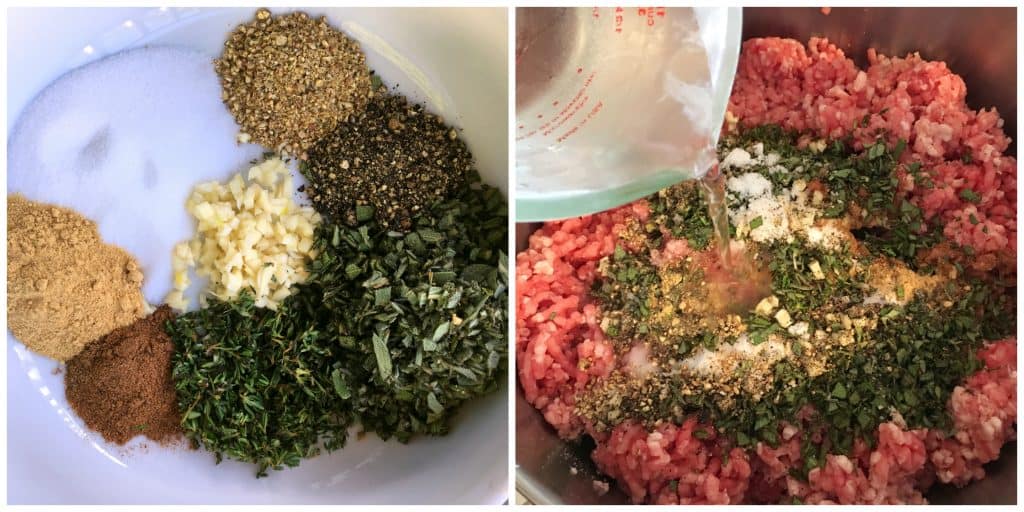
If you have room in your freezer, pre-chill the mixing bowl.
Mix the meat mixture with the paddle for 3-4 minutes until threads begin to appear in the meat: If you take a clump of meat and pull it apart with your fingers you will see tiny threads pulling apart – see pic below on right.
Chill the mixture in the fridge while you prepare the sausage stuffer. Take a bit of the meat mixture, fry it up, taste it and adjust the seasonings if needed.
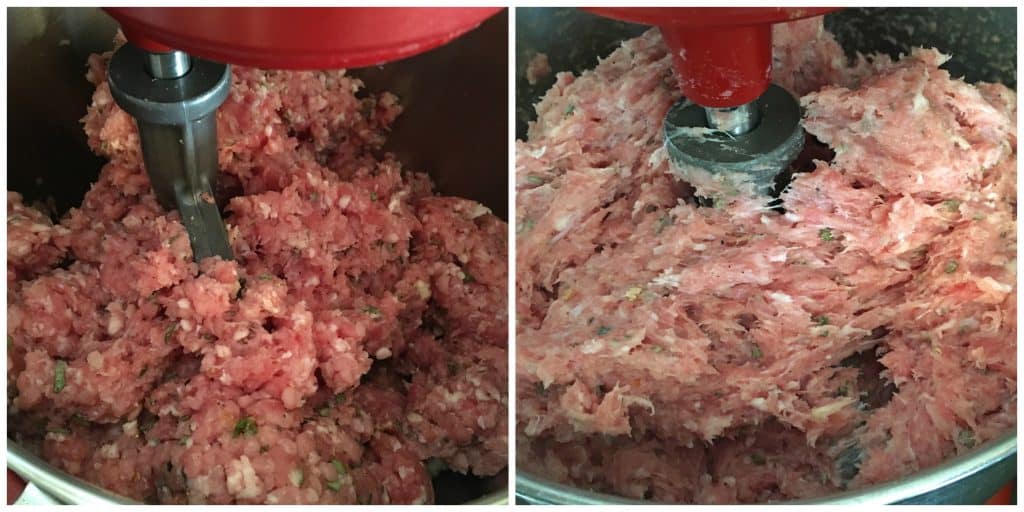
I use the Super Deal Heavy Duty 5L Vertical Sausage Stuffer and am happy with it. We very carefully researched the sausage stuffers on the market and specifically chose this one because of it’s large capacity and 100% metal construction (no plastic parts = not breakable) and because it’s easy to clean.
Thread the sausage stuffer with the prepared sheep casings, fill the sausage stuffer with the meat mixture, and fill the casings being careful to avoid air gaps while also not overstuffing the casings.
Note: Sheep casings are more challenging to work with than hog casings and they take getting used to. Be sure to keep them wet at all times and use a sufficiently small stuffing tube.
Note About Making Breakfast Sausage Patties: You can skip the stuffing process and make sausage patties instead. Simply take some of the sausage mixture in your hands, form it into a ball, press it between your palms into a patty, lay it on a lined cookie sheet and repeat, layering the patties with more parchment or wax paper to keep them from sticking to each other. Then freeze for a few hours and transfer the patties into a freezer container or ziplock bag to use as needed.
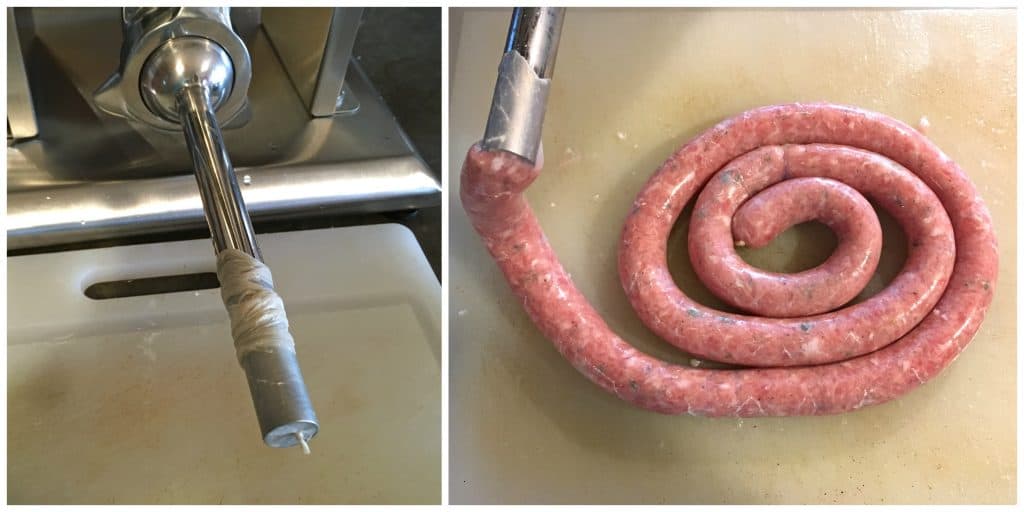
Twist the sausages into links. Use a sausage pricker to prick any air bubbles out of the links.
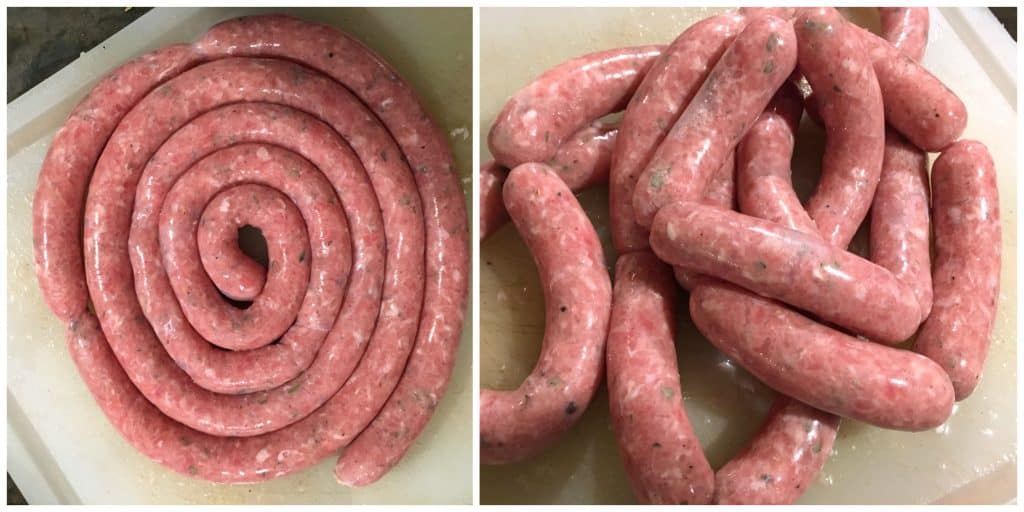
Now that the sausages are done you have two options: Cook the sausages by heating up some oil in a frying pan and frying the sausages on each side for about 3 minutes until browned and done in the middle (internal temperature of 155 degrees F).
OR you can poach the sausages (do not boil) in lightly salted water until their internal temperature reaches 155 degrees F, then let them cool in ice water, wrap them and store in the fridge for up to a week or in the freezer for up to 2 months.
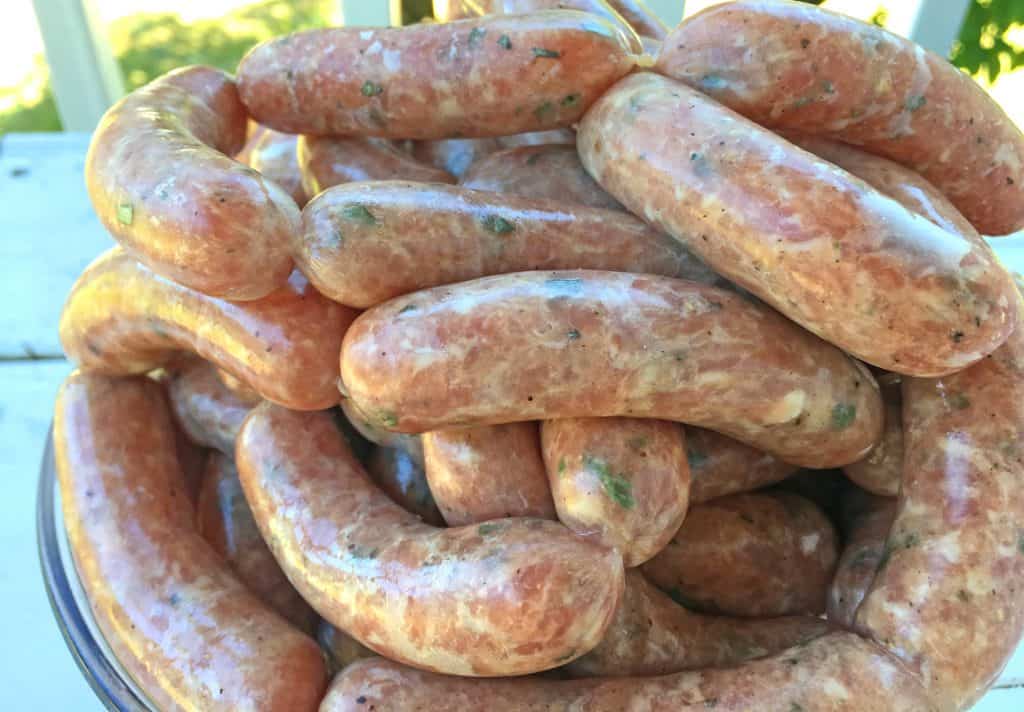
Enjoy!

For more adventures in DIY charcuterie be sure to try my:
- Italian Sausage Recipe
- Homemade Mexican Chorizo
- Homemade German Bratwurst
- Homemade British Bangers
- Smoked Ham Hocks
- How to Smoke a Ham
- Smoked Cheddar Sausages
- Italian Capicola
- How to Make Bacon
Save This Recipe
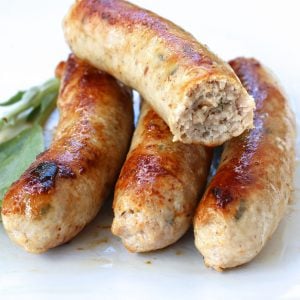
Homemade Breakfast Sausage Recipe (Links or Patties)
Ingredients
- 10 pounds boneless pork butt/shoulder (this cut is recommended for the right ratio of lean meat to fat) (can substitute 10 pounds of ground pork if you don't want to grind your own)
- 3/4 cup chopped fresh sage , or 1/4 cup dried rubbed/ground sage
- 1/4 cup chopped fresh thyme , or 2 tablespoons dried
- 5 tablespoons sea salt
- 2 1/2 tablespoons ground ginger
- 1 1/2 tablespoons freshly ground white pepper
- 1 1/2 tablespoons freshly ground black pepper
- 2 1/2 tablespoons minced fresh garlic
- 1 tablespoon ground nutmeg
- 3/4 cup pure maple syrup (optional)
- 2 cups ice water
- Natural sheep casings (3/4 inch/20 mm, about 30 feet), soaked and thoroughly rinsed
Instructions
- Cut the pork into 1/2 inch chunks and freeze them for about 45 minutes to get them to a temperature of 32 degrees F (0 celsius). Grind the pork through a 1/4 inch (6mm) die. Grind the meat quickly into the bowl of a stand mixer (ideally have the bowl set atop an ice bath to keep the meat cold) and then grind it all a second time. Chill the meat in the refrigerator while you assemble the spice mixture.In a bowl combine the salt, sage, thyme, ginger, white and black pepper, garlic and nutmeg.
- Remove the ground meat from the fridge and place it on the stand mixer fitted with a paddle attachment. (If you have room in your freezer, pre-chill the mixing bowl.) Add the spice mixture and the ice water and the maple syrup if using. Mix it with the paddle for 3-4 minutes until threads begin to appear in the meat (if you take a clump of meat and pull it apart with your fingers you will see tiny threads pulling apart). Chill the mixture in the fridge while you prepare the sausage stuffer. Take a bit of the meat mixture, fry it up, taste it and adjust the seasonings if needed.
- If making sausage patties: scoop some of the mixture into your hands and roll it into a ball (about the size of a golf ball or slightly bigger), then press it down into a patty. These can be layered on a cookie sheet with plastic wrap or wax paper between the layers, frozen, and then transferred to a ziplock freezer bag or container. If making sausage links:Thread the sausage stuffer with the prepared sheep casings, fill the sausage stuffer with the meat mixture, and fill the casings being careful to avoid air gaps while also not overstuffing the casings. Twist the sausages into links. Use a sausage pricker to prick any air bubbles out of the links.
- Cook the sausages by heating up some oil in a frying pan and frying the sausages on each side for about 3 minutes until browned and done in the middle (internal temperature of 155 degrees F). OR you can poach the sausages (do not boil) in lightly salted water until their internal temperature reaches 155 degrees F, then let them cool in ice water, wrap them and store in the fridge for up to a week or in the freezer for up to 2 months.
Notes
Nutrition
Originally published on The Daring Gourmet January 8, 2018



















just curious as I am new at this. I do plan on making a batch and freezing them. when you buy link sausages from store they do not appear to have been parboiled. what is the purpose of the parboil and is that a requirement?
Hi Steve, no it’s not necessary to parboil them first. Parboiling is for convenience, they cook faster that way (just fry them up briefly in the frying pan until browned).
Tried it and loved it. I scaled the recipe for 3 pounds of pork shoulder and the flavor was great. Also, the grind size was spot on. Definitely a keeper recipe. Thanks.
Fantastic, Alain, I’m so glad you enjoyed them an appreciate the positive feedback, thank you!
Hello!
We will try for patties and try the 10 lbs. recipe. We do not eat pork. Have you had any experience with using turkey and this recipe?
Hi Amy, yes you can use turkey. It’s just a much leaner meat (same with chicken) and so the sausages will be drier than if you were using pork.
I used this recipe to make venison breakfast sausage and it worked great! I used 25% pork fat and followed the recipe for a 20 lb batch. This will be my go to recipe from now on.
Fantastic, thank you so much, Bill!